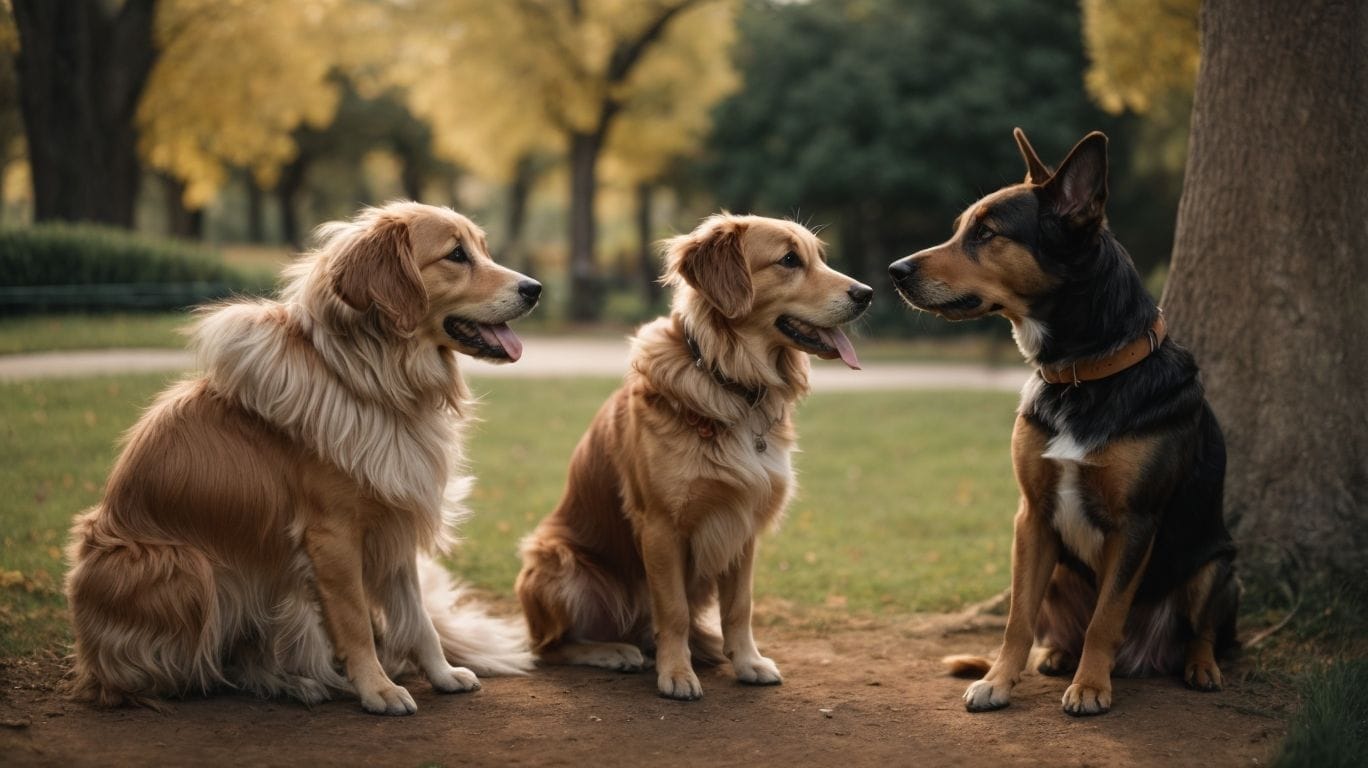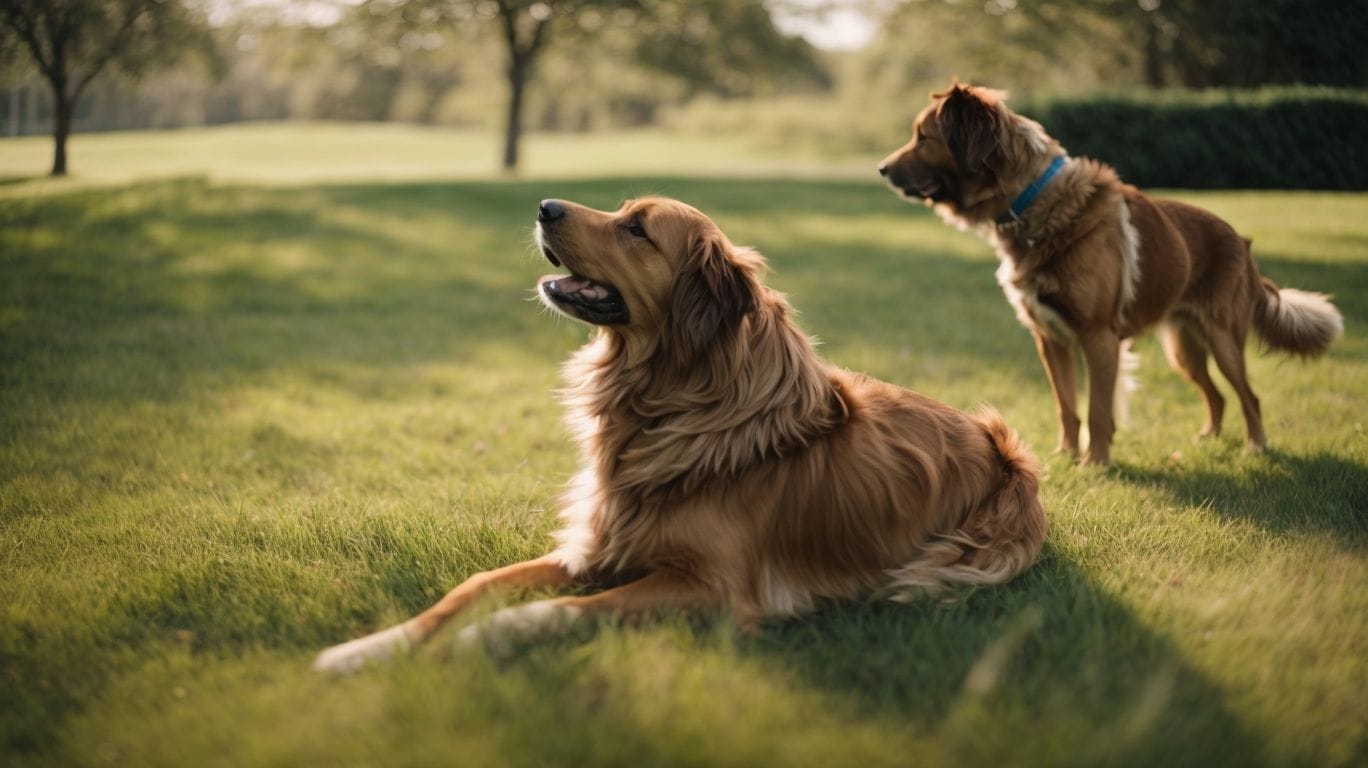Communication plays a crucial role in the social interactions of dogs. While they may not communicate in the same way humans do, dogs have their unique ways of conveying messages to each other. Understanding how dogs communicate can provide valuable insights into their behavior and help strengthen the bond between humans and their furry friends. This article will delve into the different types of canine communication, including vocal communication, body language, and scent communication. It will also explore the meaning behind various vocalizations such as barks, howling, and growling. The article will decode canine body language, discussing postures, gestures, tail wagging, ear positions, and facial expressions. The role of scent in dog communication, including marking and territorial behavior, will also be explored. Lastly, the article will provide examples of canine communication, including playful interactions, aggressive interactions, and even interspecies communication. By gaining a better understanding of how dogs communicate with each other, dog owners and enthusiasts can better interpret their pet’s needs and emotions.
Key takeaways:
- Dogs communicate through various vocalizations, body language, and scent markings. Understanding these forms of communication is key to deciphering their interactions.
- Different barks serve different purposes, from alerting to danger to expressing excitement or loneliness. Howling is a form of communication that can signify territory or call for other pack members.
- Canine body language, including postures, tail wagging, and facial expressions, is crucial in communicating emotions and intentions. Understanding these cues can help in deciphering the meaning behind interactions between dogs.
How do dogs communicate with each other?
Dogs communicate through various forms of communication, including vocalizations, body language, and scent marking.
How do dogs communicate with each other? Vocalizations such as barking, howling, and growling serve different purposes and convey different messages. Body language, including postures, tail wagging, ear positions, and facial expressions, further enhances communication. Scent plays a crucial role in dog communication, allowing them to mark territory and communicate with other dogs. Examples of canine communication include playful interactions, aggressive interactions, and even interspecies communication. Understanding these modes of communication is essential in deciphering the unique language of dogs.
Types of Canine Communication
Canine communication encompasses various forms of interaction that dogs use to convey messages and understand each other. The types of canine communication include:
- Vocalizations: Dogs use barks of different pitches, tones, and durations to communicate various meanings. For example, a high-pitched bark may indicate excitement or playfulness, while a deep, continuous bark can signal aggression or warning.
- Body Language: Dogs rely heavily on nonverbal cues such as postures, gestures, tail wagging, ear positions, and facial expressions to express their emotions and intentions.
- Scent Communication: Dogs have a highly developed sense of smell and use pheromones and other scent signals to mark territory, communicate their presence, and convey information about their gender, health, and reproductive status.
Understanding these different forms of canine communication can help dog owners better interpret and respond to their dogs’ behaviors, leading to improved interactions and a stronger bond between human and canine companions.
Understanding Dog Vocalizations

Photo Credits: Petnarnia.Com by Daniel Nguyen
Understanding dog vocalizations is crucial to interpreting their communication. Here are some cues to assist you in comprehending what your furry companion is attempting to convey:
- Barking: Dogs utilize barking to express a variety of emotions, such as alertness and playfulness, or as a warning signal.
- Growling: This vocalization indicates aggression or discomfort. It is essential to evaluate the situation and address any potential triggers.
- Howling: Frequently triggered by high-pitched sounds or as a call for attention, howling is a natural behavior in certain breeds.
- Whining: Dogs whine to convey anxiety or pain as a plea for attention. Understanding the context can assist you in responding appropriately.
What do different barks mean?
Different barks from dogs can convey various meanings and intentions. Understanding these barks can help decipher a dog’s communication. For example, a high-pitched, repetitive bark might indicate excitement or playfulness, while a deep, low bark could signal a warning or aggression. Other barks may express fear, boredom, or the need for attention or companionship. It is crucial to observe the context and body language accompanying the bark to interpret its meaning fully. By recognizing these nuances, pet owners can better understand their dog’s needs and emotions.
Pet owners often wonder, “What do different barks mean?” Different barks from dogs have specific meanings and intentions. Understanding these barks is essential in interpreting a dog’s communication. Let’s explore the interpretation of barks further.
For instance, a high-pitched, repetitive bark usually signifies excitement or playfulness. On the other hand, a deep, low bark is commonly a warning or demonstrates aggression. Dogs may also bark to express fear, boredom, or the need for attention or companionship. To fully comprehend the meaning behind a bark, it is vital to observe the accompanying body language and context. These subtle cues hold the key to interpretation.
With knowledge of these nuances, pet owners can accurately interpret their dog’s needs and emotions. By understanding what different barks mean, owners can effectively communicate and cater to their furry friend’s requirements.
Howling and its purpose
Howling is a natural form of communication for dogs, serving several purposes. Dogs can communicate with others over a large area, conveying their location, presence, and territory through howling. Additionally, howling helps coordinate activities within a pack, such as hunting or defending territory. Dogs may also howl to express loneliness, anxiety, or discomfort. Furthermore, howling can be triggered by certain sounds, such as sirens or musical instruments. Overall, howling plays a vital role in a dog’s social interaction and serves as a means of expression and communication. To ensure a harmonious coexistence with your furry companion, provide them with companionship, mental stimulation, and a calm environment.
Growling and its significance
Growling and its significance are important aspects of canine communication. Dogs frequently use growling to express a range of emotions and intentions. It is crucial for dog owners and others who interact with dogs to understand the meaning behind a dog’s growl. Growling can indicate fear, aggression, or discomfort and should always be considered a warning sign. To determine the appropriate course of action, it is essential to assess the context and observe the accompanying body language. By effectively communicating and intervening early, potential conflicts can be prevented, ensuring the safety of everyone involved.
In 1978, a German Shepherd named Max demonstrated the significance of growling in protecting his owner, Nancy, from a potential threat. Max’s low and deep growl alerted Nancy to the presence of an intruder, enabling her to call the police and stay safe until help arrived. This incident highlights the profound level of connection and protection that dogs can offer to their human companions through their growls.
Decoding Canine Body Language

Photo Credits: Petnarnia.Com by Austin Perez
We are unraveling the mysteries of canine communication in the section on decoding canine body language. From postures and gestures to tail wagging and variations and ear positions to facial expressions, we’ll dig into how dogs express themselves non-verbally. Stay tuned for intriguing insights and surprising facts as we decode the secret language of our four-legged companions.
Postures and Gestures
Dogs employ a variety of postures and gestures to communicate with one another effectively. These nonverbal cues play a crucial role in expressing their intentions and emotions. By comprehending these postures and gestures, pet owners and dog enthusiasts can gain a better understanding of a dog’s behavior. For instance, a relaxed and loose body posture typically indicates a friendly and approachable demeanor, while a stiff or tense body posture might suggest aggression or fear. To initiate or signal submission during interactions, dogs utilize gestures such as play bows and submissive postures. By paying close attention to these postures and gestures, we can significantly enhance our comprehension of canine communication.
Tail Wagging and its variations
- Tail wagging is a common form of canine communication that reveals a dog’s emotions and intentions.
- Understanding the variations in tail wagging can provide valuable insights into a dog’s feelings and behaviors.
- Here are some key variations in tail wagging and their meanings:
- Direction: The direction of a wagging tail is significant. A tail held high indicates confidence and excitement, while a tail held low suggests fear or submissiveness.
- Speed: The speed of tail wagging is also important. Rapid wagging signifies happiness and enthusiasm, while slow wagging may indicate uncertainty or caution.
- Stiffness: Another factor to consider is the stiffness of the wagging tail. A stiff and rigidly wagging tail can indicate aggression or tension, whereas a loose and relaxed wag suggests friendliness.
- Position: The position of the wagging tail can convey different meanings as well. A tail held to one side can indicate curiosity or interest, while a tail tucked tightly between the legs signals fear or anxiety.
- Context: It is crucial to consider the overall context and body language of the dog when interpreting tail-wagging behavior.
By observing and understanding these variations in tail wagging, you can gain insights into a dog’s emotions and tailor your interactions accordingly.
Ear Positions and Facial Expressions
Understanding a dog’s ear positions and facial expressions, also known as Ear Positions and Facial Expressions is crucial in deciphering their communication signals. Here is a comprehensive list of common ear positions and facial expressions and their meanings:
|
Understanding these Ear Positions and Facial Expressions can help dog owners and enthusiasts better interpret their furry friends’ emotions and respond accordingly.
The Role of Scent in Dog Communication

Photo Credits: Petnarnia.Com by Austin Harris
The Role of Scent in Dog Communication is crucial in facilitating dog communication. Dogs possess an incredible sense of smell, which enables them to gather valuable information about other dogs through their scent markings. These scent markings, which carry essential messages about a dog’s identity, territory, and reproductive status, are instrumental in fostering communication and establishing social bonds among dogs. Moreover, the scent also aids dogs in recognizing familiar individuals and discerning between friendly and unfriendly dogs. Consequently, a comprehensive understanding of the significance of scent in dog communication is imperative to comprehend their intricate social behavior.
How do dogs use scent to communicate?
Dogs use scent as a powerful tool for communication. They have a keen sense of smell, allowing them to detect pheromones and other chemical signals that convey important information. Dogs use urine marking to establish territory and communicate their presence to other dogs. They also use scent to identify individuals, determine reproductive status, and convey emotions such as fear or aggression. Sniffing each other’s rear ends is a common way for dogs to gather information about one another. Dogs have a specialized organ called the vomeronasal organ, which helps them process and interpret these scents. Fun Fact: A dog’s sense of smell is so sensitive that they can detect certain human diseases, such as cancer!
Marking and territory
| Method of Marking | Description |
| Urine marking | Dogs use scent to establish and communicate their territories to other dogs. They accomplish this through urine marking and glandular secretions. Dogs urinate on vertical surfaces to leave their scent and assert ownership of an area. |
| Glandular secretions | Dogs use scent to establish and communicate their territories to other dogs. They accomplish this through urine marking and glandular secretions. Dogs possess scent glands around their anus, which release unique pheromones to mark locations and communicate with other canines. |
Based on these markings, other dogs can determine if an area is already claimed and may choose to avoid it or engage in territorial disputes. It is fascinating how dogs use scent to establish boundaries and convey information about marking and territory to each other.
Examples of Canine Communication

Photo Credits: Petnarnia.Com by Elijah Martinez
From playful interactions to aggressive encounters and even interspecies communication, let’s take a fascinating peek into the world of canine communication. Dogs have their unique ways of expressing themselves, and in this section, we’ll delve into various examples of how they communicate with each other. Unleash the secrets behind their barks, tail wags, and subtle body language as we explore the intriguing world of canine communication.
Playful Interactions
Playful interactions between dogs are a vital aspect of their communication repertoire. Dogs utilize a range of behaviors and body language to engage in play and establish social bonds. These interactions encompass the following:
|
Fact: Playful interactions not only offer amusement but also serve as an avenue for dogs to practice social skills and enhance their physical and mental well-being.
Aggressive Interactions
During aggressive interactions, dogs communicate their intent through a variety of behaviors that include growling, baring their teeth, lunging, and snarling. These signals convey a clear warning to other dogs to back off or risk a fight. Aggressive postures, such as upright and staring, indicate dominance and assertiveness. It’s important to note that aggression can occur for various reasons, such as fear, resource guarding, or territoriality. Understanding these aggressive communication cues can help dog owners and trainers intervene appropriately to prevent escalation and ensure safety for all parties involved.
Interspecies Communication
Interspecies communication is a captivating aspect of canine behavior, showcasing their remarkable ability to interact with different animals. Let’s explore some instances of how dogs communicate with other species:
- Playful Interactions: Dogs can play with other animals, including cats or rabbits. They may utilize body language such as bowing, wagging their tails, and gentle chasing to convey their intentions effectively.
- Aggressive Interactions: In certain situations, dogs may exhibit aggression towards other animals, particularly if they sense a potential threat or invasion of their territory. They might growl, bark, or assume a defensive stance to express their unease.
- Dogs can also establish communication with humans and other species through training and conditioning. They can comprehend verbal cues and hand signals and interpret human body language to express their needs or comprehend commands.
The dogs’ ability to communicate and form connections with other species emphasizes their adaptability and friendly nature.
Some Facts About “Do Dogs Talk to Each Other?”:
- ✅ Dogs primarily communicate with each other through body language and scent cues rather than vocalizations like barking and growling. (Source: Our Team)
- ✅ Understanding the context of dog communication is crucial, as behavior that may be appropriate in one situation can be inappropriate or dangerous in another. (Source: Our Team)
- ✅ Dogs have their language to communicate with each other, using body language and actions such as facial expressions and postures. (Source: Our Team)
- ✅ Dog communication includes various signs on a dog’s face that indicate their feelings, such as relaxation, anxiety, intimidation, and playfulness. (Source: Our Team)
- ✅ Dogs use thousands of different barks to communicate, and the pitch and volume of the bark can indicate the level of emotion being expressed. (Source: Our Team)


